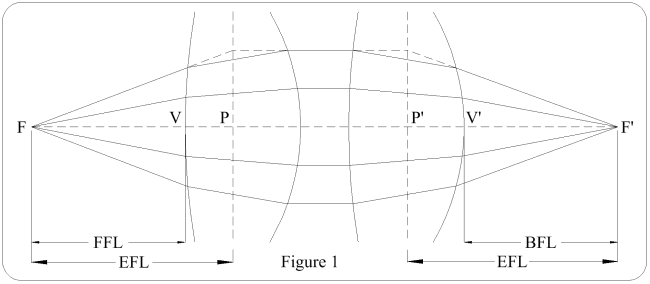
Figure 1
Most commercially available laser diodes project an elliptical beam due to the diode junction having a rectangular shape. The divergence is typically specified in both the x & y axes separately. The axis with the larger divergence is called the fast axis & the axis with the smaller divergence is called the slow axis. This elliptical beam can create difficulties for many applications & lowers the efficiency of fibre coupling. A number of techniques exist to circularize laser beams, such as anamorphic lenses, anamorphic prism pairs, micro-optics, & beam truncation.
The first surface of the lens collimates the fast axis of the laser while letting the slow axis continue to diverge. The second surface of the lens collimates the slow axis of the laser while passing the already collimated fast axis through. By collimating the fast axis of the diode before the slow axis, it allows the slow axis light to catch up to the beam diameter of the fast axis, resulting in a collimated & circular beam in a very elegant & compact package. Diode to single-mode fiber coupling can be increased to over 90% in some cases.
Anamorphic prism pairs are the most frequently used method for achieving good beam quality & circularization of laser diodes. Although this method achieves approximately 50% energy throughput, it is often difficult to align the prisms, the prisms are expensive, & the exit beam is not collinear with the laser diode - all of which make packaging difficult. Additional collimating optics are needed as well, adding to the cost & complexity.
One approaches utilizes a small cylindrical lens mounted in the laser diode, which slows down the diverging fast axis beam. This does not produce a fully collimated beam & an external collimating lens is still needed. The value-added benefit of this approach is its compact size, low cost & high-energy throughputs of approximately 75-80%.
Beam truncation is the least efficient method, & is accomplished by masking the beam with an aperture or lens. It produces a circular beam, but only 10%-30% of the beam is transmitted.
Some TO canister laser diodes have a window, which causes spherical aberration. Some collimating lenses compensate for this. Use the correct type.
Front focal length (FFL) is the distance from the front focal point to the first surface vertex.
Back focal length (BFL) is the distance from the last surface vertex to the rear focal point.
Effective focal length (EFL) is the distance from the focal point to the principal point.
Collimating lenses are designed to work at a specific wavelength. Use with other wavelengths affects the EFL, BFL & the RMS wavefront error (WFE).
Example:
| Design wavelength | EFL (mm) | BFL (mm) | WFE |
| 780nm | 1.452 | 0.876 | < 0.07 |
| 532nm | 1.424 | 0.851 | < 0.11 |
| 1550nm | 1.479 | 0.901 | < 0.08 |
Next page: Optics 2
Howard's Stuff Index
Back to Pigeon's Nest
Be kind to pigeons